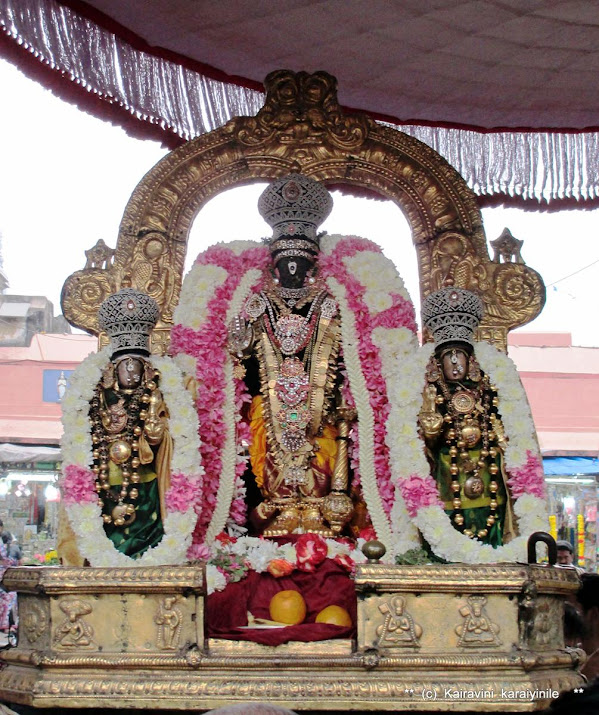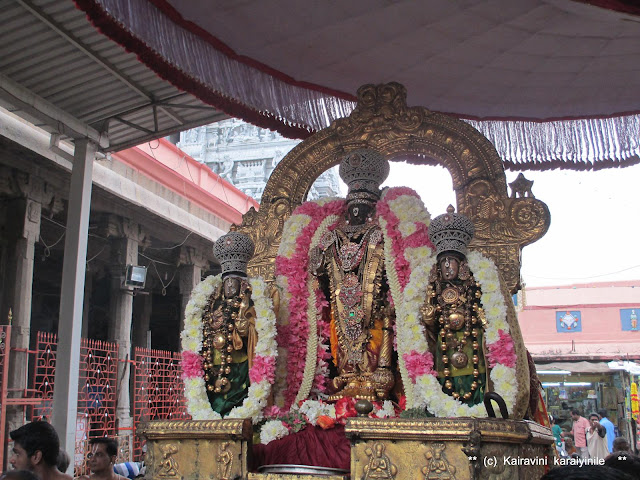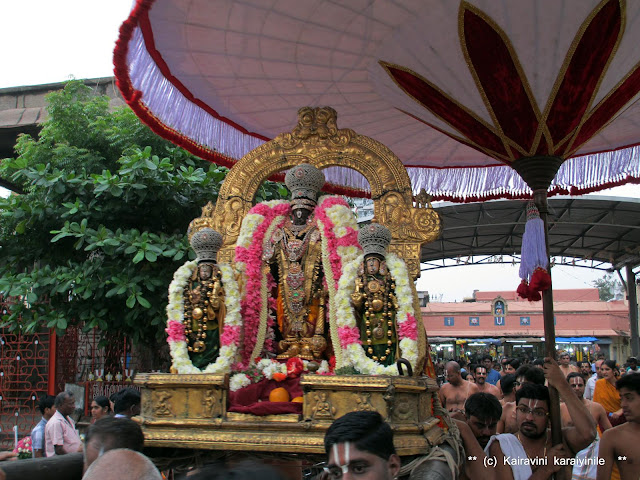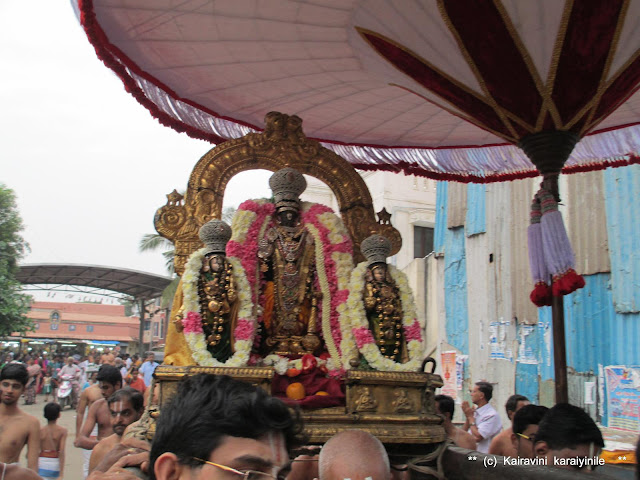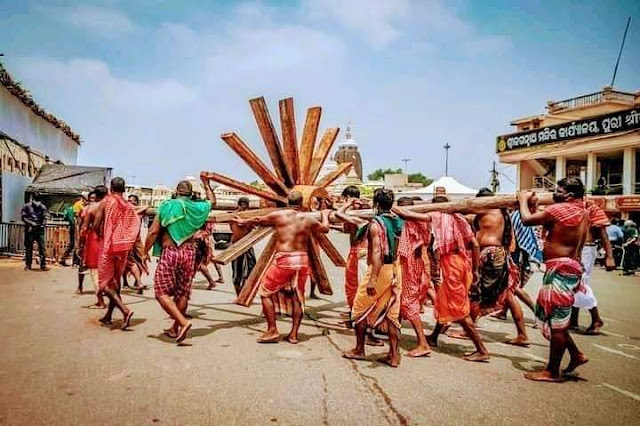If not for Corona
invading the World, today (25th June
2021) would have been day 7 of Aani brahmothsavam of Sri Azhagiya Singar
– and we would have in the morning had great darshan of Thelliya Singar in the
big thiruther at Thiruvallikkeni – alas, not to be !
ரதங்கள் (திருத்தேர்) திருக்கோவிலுக்கு
அழகு சேர்ப்பன - அவை நிற்குமிடம் ஒரு முக்கிய பகுதி - திருவல்லிக்கேணியில் தேரடி தெருவை
ஆங்கிலத்தில் கார் ஸ்ட்ரீட் என்பது மருவு !
.. .. ஊர் அமைப்பில் பிரதானமாகத் திகழ்வது தேரோடும் வீதிகளே. பண்டைக் காலத்தில்
மதுரை நகரின் அமைப்பு தாமரை மலரை ஒத்ததாக இருந்தது என்று பரிபாடல் கூறுகிறது.
மாடங்கள் சூழ் மதுரையில் தேர்வலம் வருதலையொட்டியே கீழ இரதவீதி, மேலஇரத வீதி,
தெற்கு இரதவீதி, வடக்கு இரதவீதி என்று இப்போதும் வழங்கப்படுகிறது. தேர் என்ற ஊர்தி
பண்டைக் காலத்தில் போக்குவரவிற்கும், போர் செய்வதற்கும், இறைவன் குடிகொள்ளும் நகரும் கோயிலாகவும் மிக உயர்வாக
கருதப்பட்டது.
Ratha is the
Indo-Iranian term for a spoked-wheel chariot or a cart of antiquity. In the
Indus Valley Civilization sites of Daimabad and Harappa in the Indian
subcontinent, there is evidence for the use of terracotta model carts as early
as 3500 BC during the Ravi Phase. There is evidence of wheeled vehicles - during the Harappan Period (Harappa Phase,
2600–1900 BC) there was a dramatic increase in the terracotta cart and wheel
types at Harappa and other sites throughout the Indus region. The diversity in
carts and wheels, including depictions of what may be spoked wheels, during
this period of urban expansion and trade may reflect different functional
needs, as well as stylistic and cultural preferences. Indo-Aryan Indigenists have argued for the
presence of chariots before its introduction by the Indo-Aryans in the early
2nd millennium BCE. Our famous Ithihasa puranas – Sree Ramayana and Mahabaratha
have specific references of chariots (raths) in war, elaborately description of
its Ratha sarathi (the charioteer), the flagmast symbol and more !
Thundering hooves,
spinning wheels, a cheering crowd: Envisioning an ancient Roman chariot race is
easy, but many 21st-century notions of the sport come from the writings of the
19th. Adapted several times for the big screen (the 1959 film is perhaps the
best known), the 1880 novel Ben-Hur climaxes with a thrilling chariot race.
American author Lew Wallace meticulously researched classic texts to make his
book as authentic as possible, but his passion for chariot racing comes shining
through. Wallace adored chariot racing, but ancient
Rome’s relationship to it was more complicated. The spectacle, as described by
Wallace centuries later, was indeed intoxicating, but some Roman elites looked
upon racing with disapproval. These same elites funded the construction of
massive venues for racing, such as the Circus Maximus in Rome and the
Hippodrome in Constantinople. Chariot racing’s popularity only grew as the
Roman Empire expanded. New stadiums were built in other cities, and racing
became an obsession there.
Chariot racing’s historic
roots, however, tap deep into the sacred beliefs of ancient Greece, whose games—such
as the Olympic and the Pythian events—were not considered entertainment. They
were holy activities and part of solemn religious rites. The purpose of these
events, which included chariot racing, was to please the gods, either through
sacrifice or in presenting bodily skill as an offering in itself. Homer’s epic
The Iliad features chariot races as part of the funeral games ordered by the
mourning Achilles in honor of his fallen companion, Patroclus. The word
“hippodrome” also comes from the Greek, with hippo meaning “horses” and dromos
meaning“path.” (Delphi was home to the Pythian Games, sacred to Apollo).



தேர்களைப்
பெரும்பாலும் அரசர்களும், போர் வீரர்களுமே பயன்படுத்தி வந்தனர். ராமனின் தந்தை பத்துத்திசைகளிலும்
தேர்களைச் செலுத்தும் வல்லமை பெற்றிருந்தாராம். அதனாலேயே அவர் தசரதர் என்று அழைக்கப்பட்டார்
என்கிறது புராணம். ரிக் வேதத்தில் கயிறுகளால்
இழுக்கப்படும் தேர்கள் பற்றியும், இந்திரன், வருணன், அக்கினி, சூரியன் போன்ற கடவுள்களுக்கு
தியாகத் தேர்கள் பயன்பட்டமை பற்றியும் குறிப்புகள் உள்ளன. சிலப்பதிகாரம், மணிமேகலை, சங்க இலக்கியங்கள், பன்னிருதிருமறைகள்,
புராணங்கள் ஆகியவையும் தேர்கள் பற்றிய செய்திகளை நமக்கு பெருமளவில் தருகின்றன.
தகடூர் தெரியுமா .. ஒரு காலத்தில்
சிறப்பாக விளங்கிய நகரம் - இன்றைய தருமபுரி மாவட்டம் அமைந்துள்ள இடம் ! கடைச் சங்க காலத்தில் வாழ்ந்த கொடை வள்ளல்கள்
எழுவருள்ளே அதியமான் நெடுமான் அஞ்சி என்பானும் ஒருவன். அவர் ஒரு குறுநில மன்னர். தனது ஈகை நலத்தாலும் வீர வலத்தாலும்
இணையற்று விளங்கினான். அதனால் அதியர் குடிப்புகழ் சிறப்புற்று ஓங்கியது. குடிப்பெருமையைப்
பெருக்கிய அதியமானைப் புலவர் பலரும் அதியமான் நெடுமான் என்று அகமகிழ்ந்து போற்றினர்;
அவனது இயற்பெயர் அஞ்சி என்பதே. அவன் மழவர் என்னும் வீரர் குலத்திற்குத் தலைவனாதலின்
மழவர் பெருமகன் என்றும் அழைக்கப்பெற்றான்.
இவன் ஆட்சிக்கு உட்பட்டிருந்த நாடு தலைநீர் நாடு எனப் பெயர் பெற்றிருந்தது.
தலைநீர் என்பது ஒகேனக்கல் அருவியின் சங்ககாலப் பெயர். புறநானூறு, அகநானூறு, குறுந்தொகை, பதிற்றுப்பத்து,
சிறுபாணாற்றுப்படை ஆகிய நூல்களில் நெடுமான் அஞ்சி பற்றிய குறிப்புக்கள் வருகின்றன.
ஔவையார் மற்றும் சிறந்த புலவர்கள் பலர் பாடிய
பாடல்களில் இவரைப் பற்றிய தகவல்கள் உள்ளன. திண்மையான உடல்வலி பொருந்தியவன் என்றும்;
சேரன் சோழன், பாண்டியன் உட்பட்ட ஏழு அரசர்களை எதிர்த்து நின்று வென்றவர் என்றும் புலவர்கள்
இவனைப் புகழ்ந்து பாடுகின்றனர். இவனது அரண்மனைக்கு இல்லையென்று வருவோர்க்கு அடையாத
வாயிலைக் கொண்டது என்றும், அவரது கைகள் மழையைப் போல் ஈயும் தன்மையது என்றும் பாடல்கள்
அவரைப் புகழ்கின்றன. தனக்குக் கிடைத்த சாவா மருந்தாகிய நெல்லிக்கனியைத் தான் உண்ணாது
ஔவையாருக்குக் கொடுத்தார் என்றும் அவரது கொடையின் திறம் பேசப்படுகிறது.
அவ்வையார் - அதியமான் நெடுமானஞ்சி
குறித்து தும்பை திணையில் போற்றி பாடிய
புறநானூற்று பாடல் ஒன்று இங்கே :
களம்புகல் ஓம்புமின், தெவ்விர்! போர் எதிர்ந்து,
எம்முளும் உளன்ஒரு பொருநன்; வைகல்
எண் தேர் செய்யும் தச்சன்
திங்கள் வலித்த கால் அன்னோனே.
அரசன் அதியமானின் பகைவர்களை புலவர் ஔவையார் அச்சுறுத்தும் பாடல் இது.
பிற மன்னர்களுக்கு உரைக்கிறார் : - நீர் எப்படிப்பட்டவராயினும், "அவனோடு போரிடுவோம்’
என்று மட்டும் சொல்லாதீர். ஒவ்வொரு நாளும்
எட்டுத் தேர்களை முழுமையாகச் செய்யும் ஆற்றல் மிக்க தச்சன் ஒருவன் தேர்க்கால் (தேர்ச்சக்கரம்)
ஒன்றுக்கு மட்டும் ஒரு மாத காலம் செலவிட்டு முயன்று செய்த தேர் பெற்றிருக்கும் வலிமை
போல வல்லமை மிக்க ஒரு போராளி எங்களிடமும் இருக்கிறான். எனவே, பகைவர்களே! அவனை எதிர்த்துப்
போர்களம் புகுவதைத் தவிர்த்துவிடுங்கள். அவனைக்
காண்பதற்குமுன் சொன்னது சரி, கண்டபிறகும் அவ்வாறு சொன்னால், சொல்லியபடி செய்தல் அரிதாதலை
அறிந்திருப்பீர்; ஆதலால் சொல்லாதீர்.
மற்றோரு வள்ளலான மலையமான் என்பவர்
சேர நாட்டு குறுநில மன்னர்களின் வம்சத்தவன். மலையமான் திருமுடிக்காரி சிறந்த வீரன்; பெரிய வள்ளல்; புலவர்களால் புகழ்ந்தபாடப்பட்டவன்.
இவர்கள் திருகோவலூரை தலைமையிடமாக கொண்டு ஆட்சி
செய்தனர். இம்மன்னரை போற்றி கபிலர், பாடாண் திணையில் இயற்றிய மற்றோரு புறநானூற்று
பாடல் : .
நாட் கள் உண்டு,
நாள்மகிழ் மகிழின்,
யார்க்கும் எளிதே,
தேர் ஈதல்லே;
தொலையா நல்லிசை விளங்கு
மலயன்
மகிழாது ஈத்த இழையணி
நெடுந்தேர்
பயன்கிழு முள்ளூர்
மீமிசைப்
பட்ட மாரி உறையினும்
பலவே.
கள்ளும், மகிழும் உண்டு மகிழ்ந்திருக்கும் போது தன் தேரைப் பிறருக்குக்
கொடையாக வழங்குதல் என்பது எல்லார்க்கும் எளிது. தான் உண்டு மகிழாமல் காரி மன்னன் அணிகலன்கள்
ஏற்றி வழங்கிய தேர் அவனது முள்ளூரில் பெய்த மழைத்துளிகளைக் காட்டிலும் அதிகம்.
புலவர்கள் மன்னரை போற்றி பாடியதில் மிகைகள் இருக்கும். ஏனெனில் அவை பரிசுகளை எதிர்பார்த்து இயம்பப்பட்ட
வார்த்தைகள். மிகைபட கூறுதல் கவிதை இலக்கியம். நமது இதிஹாச புராணங்கள் கதைகளோ, கவிதைகளோ
அல்ல. எம்பெருமான் ஸ்ரீமன் நாராயணனது திருவவதார மகிமைகளை உள்ளது உள்ளபடி நயம்பட உரைப்பன.
ஸ்ரீவைஷ்ணவ ஆலயங்களில் திருத்தேர் புறப்பாடு முக்கியமானது. பல நூறு பேர்கள் கலந்து கொள்ளும் ஒரு அற்புத நிகழ்ச்சி. திருத்தேரில் பற்பல சிற்பங்கள் அழகாய் அமைந்து இருக்கும். பூதங்கள், யாளி, சிம்ஹம், பாய்ந்து இழுக்கும் குதிரைகள்,
தேர்ப்பாகன் போன்ற பொம்மைகளும் தோரணங்களாக வண்ண திரைசீலைகளும் இருக்கும். எம்பெருமானுடைய பல்லாயிர திருநாமங்களை கூவி 'கோவிந்தா!,
மாதவா!, கேசவா!, நாராயணா!, கண்ணா!, மதுசூதனா, ஹ்ரிஷீகேசா' எனப்பாடி ஆனந்தித்து அவனை
அவனுறையும் பல்வேறு கோவில்களில் சென்று சேவித்து, அவனது உத்சவங்களில் வாகன சேவைகளில்
கண்டு இன்புறுகிறோம். இவற்றிற்கு மகுடமானது வருடாந்திர ப்ரஹ்மோத்சவம். இந்த பத்து நாட்கள் விசேஷ வைபவத்தில் , திருத்தேர்
கம்பீரமானது.
We were fortunate to witness this glorious
spectacle of periya thiruther for Sri Azhagiya Singar during the Special Brahmothsavam on 8.3.2021
- here are some photos of Sri Azhagiya singar thiruther
celebrations – 13 years ago ! of 2009 !!
adiyen
Srinivasa dhasan
Mamandur
Veeravalli Srinivasan Sampathkumar
25th
June 2021.
